Chengju Liu
CLASH: Collaborative Large-Small Hierarchical Framework for Continuous Vision-and-Language Navigation
Dec 11, 2025Abstract:Vision-and-Language Navigation (VLN) requires robots to follow natural language instructions and navigate complex environments without prior maps. While recent vision-language large models demonstrate strong reasoning abilities, they often underperform task-specific panoramic small models in VLN tasks. To address this, we propose CLASH (Collaborative Large-Small Hierarchy), a VLN-CE framework that integrates a reactive small-model planner (RSMP) with a reflective large-model reasoner (RLMR). RSMP adopts a causal-learning-based dual-branch architecture to enhance generalization, while RLMR leverages panoramic visual prompting with chain-of-thought reasoning to support interpretable spatial understanding and navigation. We further introduce an uncertainty-aware collaboration mechanism (UCM) that adaptively fuses decisions from both models. For obstacle avoidance, in simulation, we replace the rule-based controller with a fully learnable point-goal policy, and in real-world deployment, we design a LiDAR-based clustering module for generating navigable waypoints and pair it with an online SLAM-based local controller. CLASH achieves state-of-the-art (SoTA) results (ranking 1-st) on the VLN-CE leaderboard, significantly improving SR and SPL on the test-unseen set over the previous SoTA methods. Real-world experiments demonstrate CLASH's strong robustness, validating its effectiveness in both simulation and deployment scenarios.
Temporal-Guided Visual Foundation Models for Event-Based Vision
Nov 09, 2025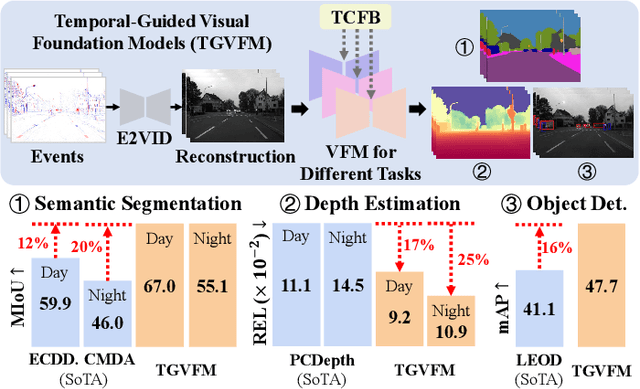


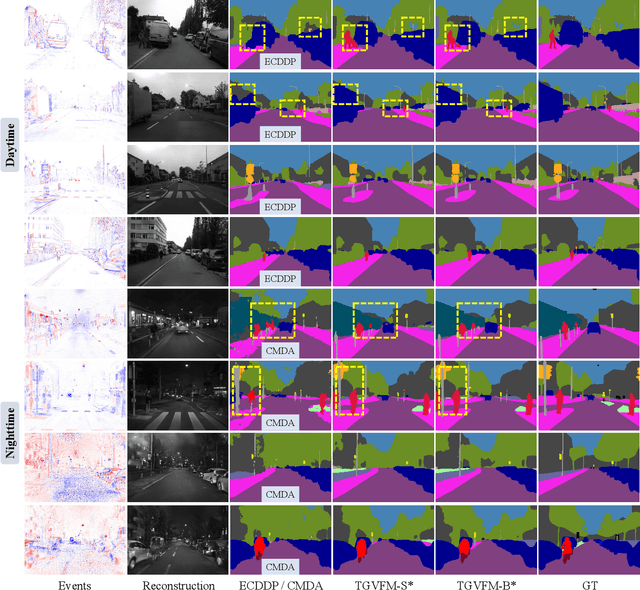
Abstract:Event cameras offer unique advantages for vision tasks in challenging environments, yet processing asynchronous event streams remains an open challenge. While existing methods rely on specialized architectures or resource-intensive training, the potential of leveraging modern Visual Foundation Models (VFMs) pretrained on image data remains under-explored for event-based vision. To address this, we propose Temporal-Guided VFM (TGVFM), a novel framework that integrates VFMs with our temporal context fusion block seamlessly to bridge this gap. Our temporal block introduces three key components: (1) Long-Range Temporal Attention to model global temporal dependencies, (2) Dual Spatiotemporal Attention for multi-scale frame correlation, and (3) Deep Feature Guidance Mechanism to fuse semantic-temporal features. By retraining event-to-video models on real-world data and leveraging transformer-based VFMs, TGVFM preserves spatiotemporal dynamics while harnessing pretrained representations. Experiments demonstrate SoTA performance across semantic segmentation, depth estimation, and object detection, with improvements of 16%, 21%, and 16% over existing methods, respectively. Overall, this work unlocks the cross-modality potential of image-based VFMs for event-based vision with temporal reasoning. Code is available at https://github.com/XiaRho/TGVFM.
Rethinking the Embodied Gap in Vision-and-Language Navigation: A Holistic Study of Physical and Visual Disparities
Jul 17, 2025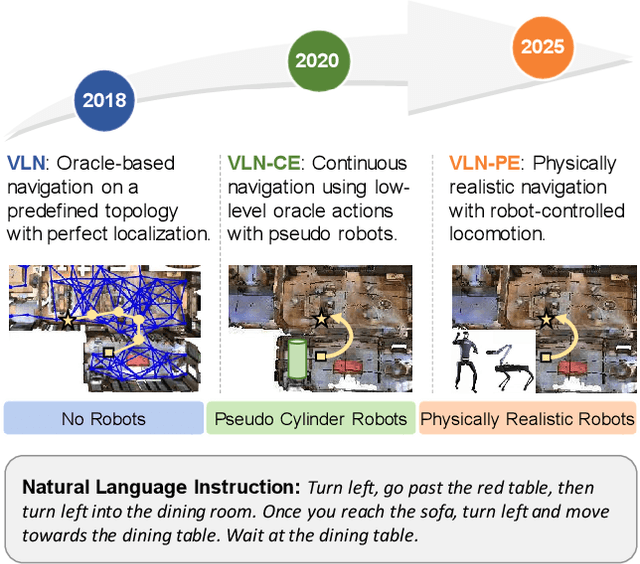
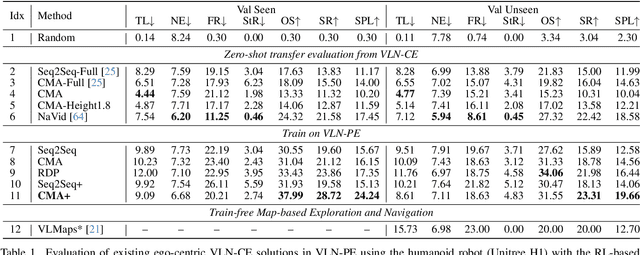
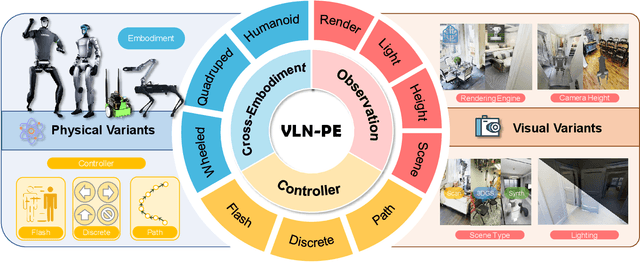

Abstract:Recent Vision-and-Language Navigation (VLN) advancements are promising, but their idealized assumptions about robot movement and control fail to reflect physically embodied deployment challenges. To bridge this gap, we introduce VLN-PE, a physically realistic VLN platform supporting humanoid, quadruped, and wheeled robots. For the first time, we systematically evaluate several ego-centric VLN methods in physical robotic settings across different technical pipelines, including classification models for single-step discrete action prediction, a diffusion model for dense waypoint prediction, and a train-free, map-based large language model (LLM) integrated with path planning. Our results reveal significant performance degradation due to limited robot observation space, environmental lighting variations, and physical challenges like collisions and falls. This also exposes locomotion constraints for legged robots in complex environments. VLN-PE is highly extensible, allowing seamless integration of new scenes beyond MP3D, thereby enabling more comprehensive VLN evaluation. Despite the weak generalization of current models in physical deployment, VLN-PE provides a new pathway for improving cross-embodiment's overall adaptability. We hope our findings and tools inspire the community to rethink VLN limitations and advance robust, practical VLN models. The code is available at https://crystalsixone.github.io/vln_pe.github.io/.
Realizing Text-Driven Motion Generation on NAO Robot: A Reinforcement Learning-Optimized Control Pipeline
Jun 05, 2025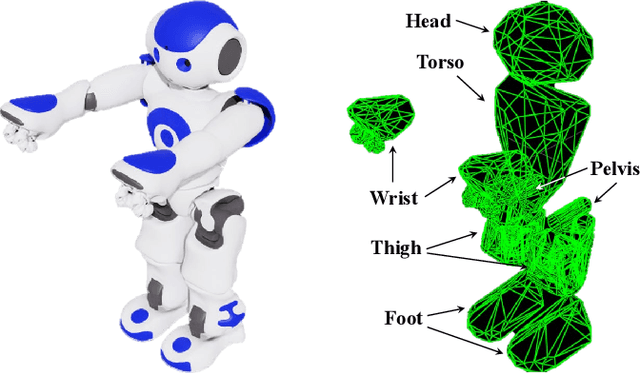
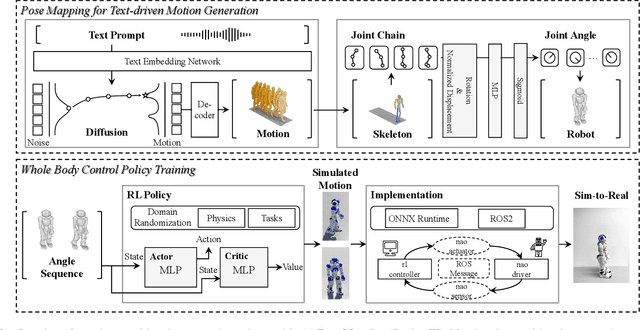
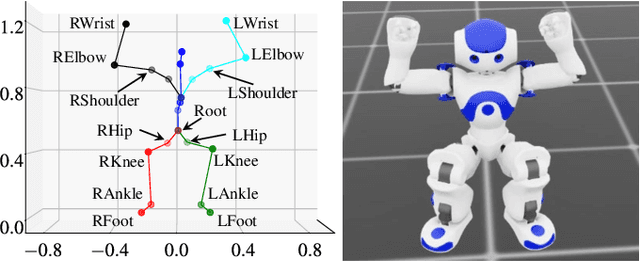
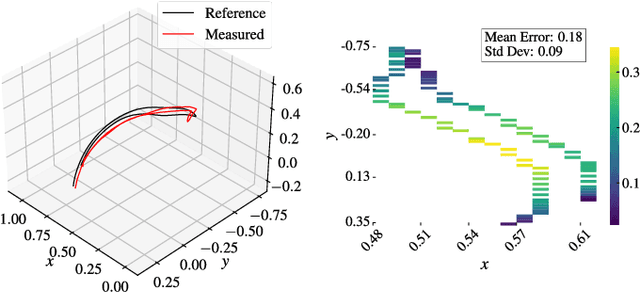
Abstract:Human motion retargeting for humanoid robots, transferring human motion data to robots for imitation, presents significant challenges but offers considerable potential for real-world applications. Traditionally, this process relies on human demonstrations captured through pose estimation or motion capture systems. In this paper, we explore a text-driven approach to mapping human motion to humanoids. To address the inherent discrepancies between the generated motion representations and the kinematic constraints of humanoid robots, we propose an angle signal network based on norm-position and rotation loss (NPR Loss). It generates joint angles, which serve as inputs to a reinforcement learning-based whole-body joint motion control policy. The policy ensures tracking of the generated motions while maintaining the robot's stability during execution. Our experimental results demonstrate the efficacy of this approach, successfully transferring text-driven human motion to a real humanoid robot NAO.
CleanPose: Category-Level Object Pose Estimation via Causal Learning and Knowledge Distillation
Feb 03, 2025



Abstract:Category-level object pose estimation aims to recover the rotation, translation and size of unseen instances within predefined categories. In this task, deep neural network-based methods have demonstrated remarkable performance. However, previous studies show they suffer from spurious correlations raised by "unclean" confounders in models, hindering their performance on novel instances with significant variations. To address this issue, we propose CleanPose, a novel approach integrating causal learning and knowledge distillation to enhance category-level pose estimation. To mitigate the negative effect of unobserved confounders, we develop a causal inference module based on front-door adjustment, which promotes unbiased estimation by reducing potential spurious correlations. Additionally, to further improve generalization ability, we devise a residual-based knowledge distillation method that has proven effective in providing comprehensive category information guidance. Extensive experiments across multiple benchmarks (REAL275, CAMERA25 and HouseCat6D) hightlight the superiority of proposed CleanPose over state-of-the-art methods. Code will be released.
MoTE: Reconciling Generalization with Specialization for Visual-Language to Video Knowledge Transfer
Oct 14, 2024Abstract:Transferring visual-language knowledge from large-scale foundation models for video recognition has proved to be effective. To bridge the domain gap, additional parametric modules are added to capture the temporal information. However, zero-shot generalization diminishes with the increase in the number of specialized parameters, making existing works a trade-off between zero-shot and close-set performance. In this paper, we present MoTE, a novel framework that enables generalization and specialization to be balanced in one unified model. Our approach tunes a mixture of temporal experts to learn multiple task views with various degrees of data fitting. To maximally preserve the knowledge of each expert, we propose \emph{Weight Merging Regularization}, which regularizes the merging process of experts in weight space. Additionally with temporal feature modulation to regularize the contribution of temporal feature during test. We achieve a sound balance between zero-shot and close-set video recognition tasks and obtain state-of-the-art or competitive results on various datasets, including Kinetics-400 \& 600, UCF, and HMDB. Code is available at \url{https://github.com/ZMHH-H/MoTE}.
RoadFormer+: Delivering RGB-X Scene Parsing through Scale-Aware Information Decoupling and Advanced Heterogeneous Feature Fusion
Jul 31, 2024



Abstract:Task-specific data-fusion networks have marked considerable achievements in urban scene parsing. Among these networks, our recently proposed RoadFormer successfully extracts heterogeneous features from RGB images and surface normal maps and fuses these features through attention mechanisms, demonstrating compelling efficacy in RGB-Normal road scene parsing. However, its performance significantly deteriorates when handling other types/sources of data or performing more universal, all-category scene parsing tasks. To overcome these limitations, this study introduces RoadFormer+, an efficient, robust, and adaptable model capable of effectively fusing RGB-X data, where ``X'', represents additional types/modalities of data such as depth, thermal, surface normal, and polarization. Specifically, we propose a novel hybrid feature decoupling encoder to extract heterogeneous features and decouple them into global and local components. These decoupled features are then fused through a dual-branch multi-scale heterogeneous feature fusion block, which employs parallel Transformer attentions and convolutional neural network modules to merge multi-scale features across different scales and receptive fields. The fused features are subsequently fed into a decoder to generate the final semantic predictions. Notably, our proposed RoadFormer+ ranks first on the KITTI Road benchmark and achieves state-of-the-art performance in mean intersection over union on the Cityscapes, MFNet, FMB, and ZJU datasets. Moreover, it reduces the number of learnable parameters by 65\% compared to RoadFormer. Our source code will be publicly available at mias.group/RoadFormerPlus.
Accurate Prior-centric Monocular Positioning with Offline LiDAR Fusion
Jul 12, 2024Abstract:Unmanned vehicles usually rely on Global Positioning System (GPS) and Light Detection and Ranging (LiDAR) sensors to achieve high-precision localization results for navigation purpose. However, this combination with their associated costs and infrastructure demands, poses challenges for widespread adoption in mass-market applications. In this paper, we aim to use only a monocular camera to achieve comparable onboard localization performance by tracking deep-learning visual features on a LiDAR-enhanced visual prior map. Experiments show that the proposed algorithm can provide centimeter-level global positioning results with scale, which is effortlessly integrated and favorable for low-cost robot system deployment in real-world applications.
MAGIC: Meta-Ability Guided Interactive Chain-of-Distillation for Effective-and-Efficient Vision-and-Language Navigation
Jun 25, 2024Abstract:Despite the remarkable developments of recent large models in Embodied Artificial Intelligence (E-AI), their integration into robotics is hampered by their excessive parameter sizes and computational demands. Towards the Vision-and-Language Navigation (VLN) task, a core task in E-AI, this paper reveals the great potential of using knowledge distillation for obtaining lightweight student models by proposing a Meta-Ability Guided Interactive Chain-of-distillation (MAGIC) method. Specifically, a Meta-Ability Knowledge Distillation (MAKD) framework is proposed for decoupling and refining the necessary meta-abilities of VLN agents. A Meta-Knowledge Randomization Weighting (MKRW) and a Meta-Knowledge Transferable Determination (MKTD) module are incorporated to dynamically adjust aggregation weights at the meta-ability and sample levels, respectively. Move beyond the traditional one-step unidirectional distillation, an Interactive Chain-of-Distillation (ICoD) learning strategy is proposed to allow students to give feedback to teachers, forming a new multi-step teacher-student co-evolution pipeline. Remarkably, on the R2R test unseen public leaderboard, our smallest model, MAGIC-S, with only 5% (11M) of the teacher's size, outperforms all previous methods under the same training data. Additionally, our largest model, MAGIC-L, surpasses the previous state-of-the-art by 5.84% in SPL and 3.18% in SR. Furthermore, a new dataset was collected and annotated from our living environments, where MAGIC-S demonstrated superior performance and real-time efficiency. Our code is publicly available on https://github.com/CrystalSixone/VLN-MAGIC.
SAM-LAD: Segment Anything Model Meets Zero-Shot Logic Anomaly Detection
Jun 02, 2024Abstract:Visual anomaly detection is vital in real-world applications, such as industrial defect detection and medical diagnosis. However, most existing methods focus on local structural anomalies and fail to detect higher-level functional anomalies under logical conditions. Although recent studies have explored logical anomaly detection, they can only address simple anomalies like missing or addition and show poor generalizability due to being heavily data-driven. To fill this gap, we propose SAM-LAD, a zero-shot, plug-and-play framework for logical anomaly detection in any scene. First, we obtain a query image's feature map using a pre-trained backbone. Simultaneously, we retrieve the reference images and their corresponding feature maps via the nearest neighbor search of the query image. Then, we introduce the Segment Anything Model (SAM) to obtain object masks of the query and reference images. Each object mask is multiplied with the entire image's feature map to obtain object feature maps. Next, an Object Matching Model (OMM) is proposed to match objects in the query and reference images. To facilitate object matching, we further propose a Dynamic Channel Graph Attention (DCGA) module, treating each object as a keypoint and converting its feature maps into feature vectors. Finally, based on the object matching relations, an Anomaly Measurement Model (AMM) is proposed to detect objects with logical anomalies. Structural anomalies in the objects can also be detected. We validate our proposed SAM-LAD using various benchmarks, including industrial datasets (MVTec Loco AD, MVTec AD), and the logical dataset (DigitAnatomy). Extensive experimental results demonstrate that SAM-LAD outperforms existing SoTA methods, particularly in detecting logical anomalies.
 Add to Chrome
Add to Chrome Add to Firefox
Add to Firefox Add to Edge
Add to Edge